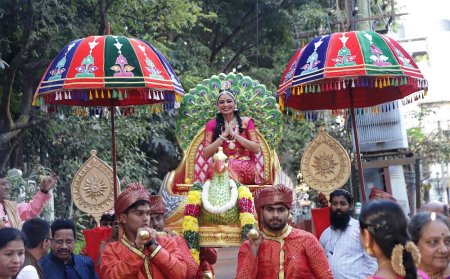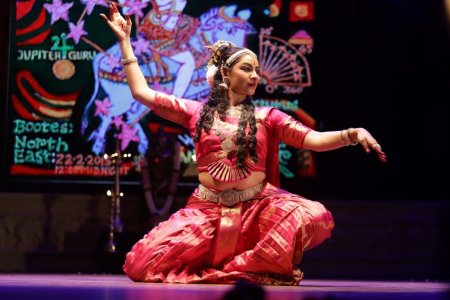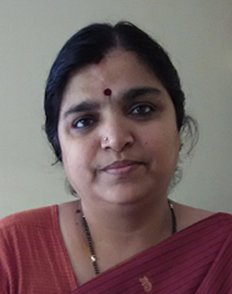
|   |

|   |
Navasandhi - A rich temple dance tradition - Sudha Sridhar e-mail: sudhasridhar@hotmail.com Photos: Rajesh TK & Shivu March 21, 2024 The last weekend of the year 2023 on Saturday, December 30th, Bangalore witnessed a cultural extravaganza at the hallowed Chowdiah Memorial Hall, a presentation of Navasandhi in Kuchipudi classical art form by Guru Veena Murthy Vijay through her very able ally, disciple Sangeetha Phaneesh. Veena Murthy's attempt to bring back awareness and focus on this unique temple dance repertoire, that too for the first time in Kuchipudi style is really a commendable endeavour. Navasandhi is a very deep subject, which entails a well-researched article and hence this report purports to only provide basic information to kindle further interest.  In the temple dance traditions, different types of worship of the presiding deity were performed and it is a well acknowledged fact that classical dance or Nritya Seva, was one of them. Navasandhi was one such performance which was an essential part of Brahmotsava or other major utsavs performed in the temples. It is also said as part of honouring scholars during the utsavs by the rulers of Kakatiya and Krishnadevaraya empire, they were carried in pallaki (palanquin) from their residence to the temple and there Navasandhi, basically Kavutuvams - prayers composed on the deity - with similar jathis was performed to the deities at each direction. This was followed up with dance primarily extolling the presiding deity of the temple. This tradition seems to have vanished over a period of time, along with the slow fading of the traditional temple dancers. The programme started with pooja at Kadumalleshwara Temple, Malleshwaram and procession of the dancer on a pallakki to the venue of performance, Chowdaiah Memorial Hall. The evening probably for the first time introduced to the spellbound audience, the fact that the worship of the presiding deity of all the directions had specific Bija Akshara, Dhyana, mantras, raga, flowers, and colours, a unique speciality of Navasandhi. Starting with the specific raga being played in the traditional instrument for auspicious occasions, the Mangala Vadhya nadaswaram, followed with chanting of the mantra from Krishna Yajur Veda by the pundits as per the Agama Sastra, worship with specific sugandhara flowers and colours associated with the deity, for example lavender for Lord Agni, Parijatha for Lord Indira, etc.  Veena Murthy has attempted to blend both the Vaishnavism and Saivism methodology of performing Navasandhi, following Agama sastra mantras and Pancharatra talas. The songs as part of descriptive daruvus from the traditional temple dance had pallavi, anupallavi which were mostly in desi talas. This has been very meticulously converted to sapta talas after a research oriented collaborative effort with well-known Carnatic music scholar Dr. T. S. Satyavathi, lifting the rendition of Navasandhi to dizzy heights. The stage setting for the performance was awe inspiring. It comprised of a mantap of a temple with the presiding deity placed in the middle (Lord Krishna being the chosen main deity for the evening performance), to the left of the stage saw the musicians playing the nadaswaram and the thavil (G Ravi, G Naveen Kumar and team), the right most side of the stage saw the accompanying musicians playing the veena (Amrutha Vishwanath), mridangam (Vinod Shyam), flute (Mahesh Swami), rhythm pad (Pranav Dath) with next in line being that of nattuvangam by Veena Murthy herself, vocalist (Eshwar Iyer and Deepthi Srinath) and towards the centre the Veda Ghosha (Bharath Bhattar and team).  The background of the stage saw a giant screen showcase the descriptions, visuals, corresponding images related to the deity portrayed by the dancer, for example for water - all the forms of water were displayed. It also captured the special paintings related to the deity from the work 'Ashtadikpalaka' by renowned artist H N Suresh, based on his research on astronomical paintings on constellations, navagrahas, ashtadikpalakas and deity positions. In this backdrop, the performance of the artist of the day Sangeetha Phaneesh, associated with each direction was outstanding, acrobatic, flawless, spontaneous, graceful and evoked the desired emotions associated with the deity of the directions. The enchanting Navasandhi was followed with 'Hamsavahini' Chitra Nritya, wherein with deft dance movements on a canvas which was laid on the stage, the outline of Hamsavahini was brought out in an exquisite manner. The picture that was drawn by way of dance movements and the feet was captured by special cameras and displayed in the background screen bringing the audience to their feet. Keeping to the tradition of Navasandhi, the next performance was on the deity of the day, Lord Krishna, a few daruvus from the famous magnum opus of the seer of Kuchipudi, Siddendra Yogi's 'Bhama Kalapam'. For the benefit of the local audience, Bhama Kalapam translated from Telugu language to that of Kannada by Shatavadhani R Ganesh was presented with Veena Murthy doubling up as Sakhi with her mono acting. She was at her best with her wit and had the hall in splits, enjoying her banter with the teasing of the already beleaguered Satyabhama who was missing the loving presence of Lord Krishna, seeking her assistance to reach out to Lord Krishna. The last item was that of Krishna tarangam where jathis were performed on brass plate in tune with the unique tradition of Kuchipudi classical dance form. To put together such an unforgettable event would not have been possible if not for the true intention backed by abundance of divine grace as rightly pointed out by Nagamani Buddhadev, a renowned Kuchipudi exponent who was felicitated as part of the program. Also as very succinctly put forth by music scholar T.S. Satyavathi during her felicitation, Navasandhi by Veena Murthy through Sangeetha was not merely a 'Pradarshana' but actually 'Darshana' of divinity. The entire evening was a once in lifetime experience, what with the very painstaking recreation of Navasandhi, bringing back to life what transpired as part of the rich alaya sampradhayam, in spellbinding grandeur is not an easy affair; it requires sheer hard and meticulous work right through the entire process. One is tempted to add that the well-researched and presented Navasandhi did provide the opportunity to savour and appreciate the past, but it would augur well if this rich cultural heritage is once again brought back as part of the various festivities of the temple dance tradition and any concerted efforts in that direction would do a great favour for the present and future generations.  Sudha Sridhar, a double graduate in Law & Dance, is a cultural activist working on advocacy efforts to preserve, promote and propagate art forms and for the cultural rights and welfare measures for artistes. Her main focus is on Kuchipudi heritage village and promotion of all the three streams of South Indian Yakshagana - Karnataka Yakshagana, Kuchipudi Yakshaganam and Melattur Bhagavatamela. |